Portland pupils keep riding cars to school less, and walking and biking more.
Survey data released by the city Wednesday show a continuing upward climb in active transportation to school. Among Portlanders in kindergarten through fifth grade, walking, biking and otherwise rolling to school became more common than traveling in the family vehicle sometime around 2010 and has more or less kept climbing since.
If the trend continues, more than half the city’s primary schoolers will be walking, biking, skating or scootering to school by 2025 or so.
Advertisement
It’s worth noting that riding in a car isn’t the only thing becoming less common; riding a school bus has been, too. Here’s the detailed trend. (Note that unlike the chart at the top, the last few data points include students from grades 6-8 as well as younger ones.)
The city breaks out survey data by school. If a school you care about has been surveyed, the latest data is here.
Coincidentally, the news comes just as the For Every Kid Coalition delivers a big bundle of testimony to Metro in favor of creating a regional Safe Routes program. The coalition’s $15 million ask would include a bit for instructional classes (that the Bicycle Transportation Alliance might teach), but mostly for biking and walking-friendly infrastructure improvements to the streets immediately surrounding Portland-area schools.
Portland voters will also have an option to give their own booster shot to these efforts in May when they consider a 10-cent gas tax hike that would send a large share of its proceeds to biking and walking upgrades to streets near Portland schools.
Learn more at SafeRoutesPortland.org.
— Michael Andersen, (503) 333-7824 – michael@bikeportland.org
BikePortland can’t survive without paid subscribers. Please sign up today.

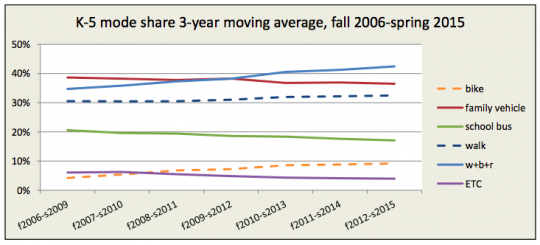
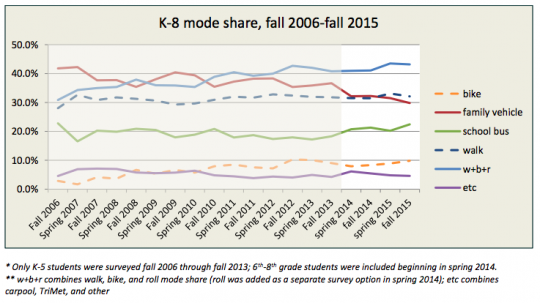
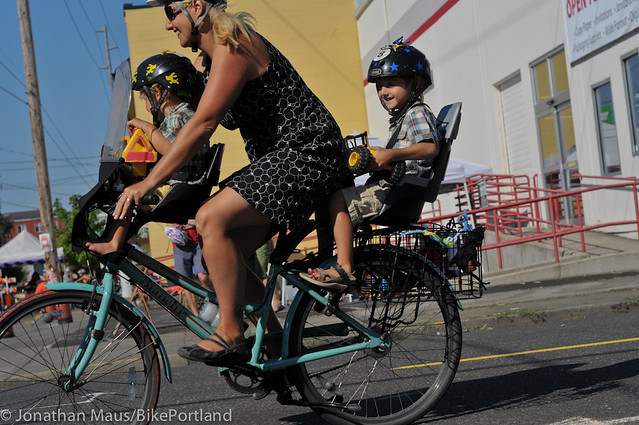
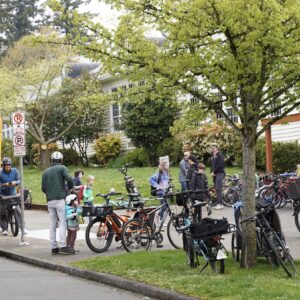
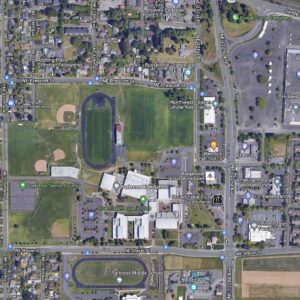
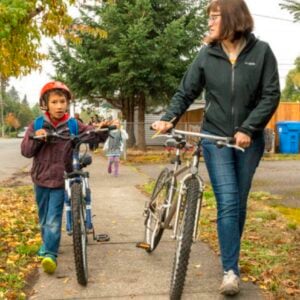
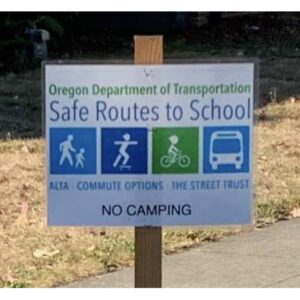
Thanks for reading.
BikePortland has served this community with independent community journalism since 2005. We rely on subscriptions from readers like you to survive. Your financial support is vital in keeping this valuable resource alive and well.
Please subscribe today to strengthen and expand our work.
I wish PPS would consider this while redrawing school boundaries and setting policy. IMO, they are trying to create an illusion of equity by forcing kids in wealthier neighborhoods to attend/invest time and money in the underserved schools. As a result, the high school my kid is supposed to go is among the worst in the nation and is 30%-50% farther from my house than other/better high schools. Of course, PPS has do SOMETHING to try to turn these schools around after years of neglect, but some real investment in staff/campus would be a better place to start (instead of trying to do it on the backs of parents)
I agree. I live right across the street from Franklin on 52nd and one of the proposed redistricting maps places the boundary on 52nd. This means that people that can literally see the school across the street would have to go to Cleveland HS, two miles away. School boundaries should instead be a radius around the school based on a 20-minute walk.
Unfortunately, there are much more important needs in public schools than getting there quickly (or by foot and/or tire). You write quite a bit about equity and privilege on this Board, and these are needs that have to be addressed.
Of course. But there’s no harm in expressing concerns about less important issues, as well.
Of course. But that concern is in conflict with the bigger issues.
“Baby On Board” placards appeared in car windows in the mid-’80s, followed a few years later by a surge in kids being driven to schools even in locales in which it had been almost eradicated like Davis.
Oops, meant to put this in reply to Clark, below.
“A 2010 meta-analysis found that students of all socioeconomic statuses, races, ethnicities, and grade levels were likely to have higher mathematics performance if they attended socioeconomically and racially integrated schools. …
Socioeconomic integration is a win-win situation: Low-income students’ performance rises; all students receive the cognitive benefits of a diverse learning environment (Antonio et al., 2004; Phillips, Rodosky, Muñoz, & Larsen, 2009); and middle-class students’ performance seems to be unaffected up to a certain level of integration. Research about this last point is still developing. A recent meta-analysis found “growing but still inconclusive evidence” that the achievement of more advantaged students was not harmed by desegregation policies (Harris, 2008, p. 563). It appears that there is a tipping point, a threshold for the proportion of low-income students in a school below which middle-class achievement does not suffer.”
http://www.ascd.org/publications/educational-leadership/may13/vol70/num08/Boosting-Achievement-by-Pursuing-Diversity.aspx
That said, I’d personally agree that other things being equal it’s nice when people can attend their community schools.
I agree with that, Michael. My frustration is that PPS has a strategy for improving underperfoming schools that relies on convoluted boundaries to try to pressure families from higher-performing schools to move to low-performing schools; hoping these families will become involved, raise funds and help turn the school around. The problem is that a high percentage of these families simply WILL NOT send their kids to the under-performing school- they will move, opt for private school, or find way to get their kid into whatever school they want. Most of these schools have fairly economically, at least populations around them. What PPS needs to do is provide equitable resources to all schools, to show some commitment to these populations. Once they start turning around, the school will attract more of the community.
Statistically, and over a long enough timeline.
We cannot, in good faith, claim that we are not asking parents to sacrifice the education of their children for the greater good. It is simply not true that on day one their child will receive the same education at “bad school” as they would have at “good school”.
Given enough time, and if things are doing correctly, sure it can work out. Does it ever really though? Perhaps this is part of the reason many parts of the country switched to huge schools, to avoid having to pick winners and losers.
Does anybody know when this trend of driving kids to school started?
It seemed to be either the ’80s or ’90s but I didn’t pay attention. Now it’s become “normal” for many places.
When I grew up I think I got driven to school twice. Once when my older sister got her first car and wanted to use it for everything, the other time when it was 40 below and they said our lungs would freeze if we walked.
When I went to school in the 90’s in suburban Chicago, I walked to my neighborhood elementary school (by myself even!) and took the school bus to middle school and junior high. It wasn’t until junior year of high school that I was driven, usually by a friend since I didn’t get my driver’s license until after I graduated.
In 1969, nearly 50 percent of all children in the United States (and nearly 90 percent of those within a mile of school) walked or bicycled to school. It’s been downhill ever since — except in places like Portland, which have put a concerted effort in to reversing the trend.
source: http://saferoutespartnership.org/healthy-communities/101/about
When I started school in ’95, I was always driven to school. It was a private school and it was about 2 miles away from my house. I didn’t realize that walking to school was even an option until I was about 17. It didn’t help that there was a very steep hill and 2 very busy roads on the way to the school.
When I started high school, I was driven to school by friends who lived nearby. Eventually I started driving myself, but not very legally (I didn’t have a driver’s license and I definitely didn’t have insurance or anything).
My perception is it really got going in the 1990s. The Jacob Wetterling case, a few other highly publicized child abductions and the resulting milk carton ads basically killed off free range childhood.
Then everyone got freaked out, and started driving their kids to school and taking them to playdates – instead of letting them run over to the local park or the neighbors’ house.
Younger people may not realize it, but until at least the 1980s it was perfectly normal for kids to walk and bike to school, and to roam freely around the neighborhood after school. Abductions weren’t unheard-of, and we were taught about “stranger danger”, but we didn’t revolve our lives around the risk. Now I can’t even let more than a few yards come between me and my kids in public, or do-gooders will come up to me and warn me about the danger I’m supposedly putting them in. In many states, CPS has taken kids away from parents that let them range freely – or simply walk to school. It is truly insane.
I think the rise of “school choice” in the 80s and 90s also contributed to these changes, with fewer kids going to neighborhood schools, but IMO it’s the abduction paranoia that was the biggest factor.
Never mind that more kids are killed being driven to school than ever were in stranger abductions (which never exceeded a few dozen per year).
I live near the Alameda elementary school in one of the most pleasant walkable neighborhoods in the city. The streets around the school are jammed with cars in the morning dropping off and the in the afternoon picking up.
I would call “safe routes” a Fail…….
ETC?
The problem is people who do drive their kids make it harder for those who don’t.
Indeed. We have speeders buzzing in front of our house every morning, across our kids’ path to school. These drivers are taking their kids to school.
I’ve witnessed the same thing. Someone yelled and honked at me on Clinton the other day, then passed me way too closely because he “had to get his kids to school”.
Does anyone else ask if “safe routes” is counter productive? By focusing on safety, does “safe routes” reinforce the cultural excuse that it is not safe to walk to school? Do the 40% that ride private cars to school truly have no safe alternatives?
Suggested alternative – “Get off your backside and walk” – Worked for my kid.
If our bike infrastructure was built to be safe for all ages, we wouldn’t even need safety education.
Oh come on, that’s a super hypocritical remark, even from you, Adam. The reason the Netherlands is such a bicycling paradise has a lot less to do with the infrastructure, than with that fact that the Dutch have an extensive safety education program that begins when you are a child and continues until you are an adult, so that Dutch cyclists and motorists all have a better appreciation for the potential of their actions to affect the safety of others.
This is true, but most the education is directed at the people driving, who are the most capable for causing harm. Teaching safe walking and cycling classes only entrenches the belief that the car is king of the road and everyone must learn to behave around them. We need to be far better in this country about teaching potential drivers how to safely operate around vulnerable road users.
No, Dutch safety education starts in the schools with safe cycling classes.
Because well-trained young cyclists grow up to be more responsible and considerate motorists (at least in Holland).
The Netherlands is notorious for it’s scofflaw cycling culture. As a committed cycling scofflaw I very much want Portland to emulate the Dutch.
Based on my limited observation of Dutch cycling, it can’t be because of their safety education. One way to carry you child was for them to stand on the rack holding onto you shoulders. This can’t be safe, but it sure looked fun.
Maybe instead of fretting about minute risks they just go out and have fun.
The biggest hazard to children walking to school is parents driving their kids to school. (EPA study)
If traffic laws were enforced and more students walked, the infrastructure we have would look much safer.
While I welcome and support the trend of kids going to school on their own—as I did, uphill five miles both ways in sixty feet of snow until June—I hope this isn’t simply a regression to that de facto segregation of schools to neighborhoods of haves and have-nots.
It is no small coincidence that fewer children are walking to school than when schools were formally segregated by policy and economically segregated by redlining. Nobody is walking to school when it’s ten miles across town.
I can’t pretend to have the answers for education. What I know is that it’s inequitable for students and teachers alike, and money alone doesn’t make that go away. Who in any sector doesn’t blame underperformance on the budget?
I’m suspicious of the data set and the analysis.
When my kids were in middle school, I responded to the PBOT/PPS surveys. I don’t remember seeing one once they were in high school.
I strongly suspect that the response rate was pretty low and from what I remember a substantial number of the questions were focused on non-auto travel. The incentive gifts, like Safe Routes to Schools water bottles” would appeal more to those who walked or biked. That encourages responses from those segments.
I suspect that those who drive their kids to school may have given up responding to the survey. A lower response rate from those who drive kids to school would boost the percentages of bicycling and walking even if the numbers don’t change.
I’d take the conclusions with a grain of salt.
That’s all totally valid except for the part that this shows a long-term trend. Is there a good reason to think the response bias has been changing over the years?
The response rate from some of these schools is shockingly low. Below 3% ? How is that even possible?
So, 11.4% return overall. The numbers are interesting, and they are what they are. I wouldn’t personally feel comfortable presenting them as evidence of anything, even if I wanted the trend to be true.
PBOT only surveys elementary and middle schools. PBOT does not have a safe routes to high schools program. (and it’s just one person that conducts and compiles the surveys)
I never had the option of walking to school growing up in E. Portland. There was (still is) no sidewalk/shoulder on a fast narrow road where I grew up, so it was and remains difficult to walk to my parents house. My grade and middle school were a ten minute walk at most. This barrier no doubt remains for some kids in E.
If we could prohibit front-of-school dropoffs, that would alleviate many of the remaining problems. Even spreading that load out to 1-2 blocks from school would help reduce contention for roadway and alleviate a huge source of risks from having too many cars in a small area. I’ve seen many close calls between these front-of-school moms and dads and other pedestrians, cars and bikes.
I agree with you. Although, many parents drive their kids because they erroneously think that they’re keeping their kids safe. Never mind the irony that the streets are only unsafe because of all the cars. How would you argue against this?
It is very common to see cars pull over at the yellow curb around the crosswalk in front of our school. They think it’s ok because they remain at the wheel. Unfortunately, it impacts safety / visibility around the crosswalk.
I’m not aggressive enough to complain to these drivers…
PBOT encourages walking school buses, bike trains and drop and walk programs.
I hope ETC is skateboarding and scooting!
From the second graph: “ETC combines carpool, TriMet, and other”.
I taught my 5th grader how to ride a skateboard so that he could skate to school, which he did for 3 years, until this past September when bus service was cut for ~330 students. Now the 3-foot-wide path that he used to use to get to school is being used by ~200 kids plus their parents, and there’s no room on the path for kids on wheels, so he rides his bike next to the path.
The grass on either side of this path has been turned to mud from all of the bike traffic, which in turn has caused the path to flood so the kids on the path have to walk through puddles ~20 feet in diameter. I won’t let him ride his normal bike to school — he is riding his old bike, which is too small for him and is covered in mud.
This path, the one that the district routed everyone to (and used in their route calculations for cutting the bus routes) is pretty much a disaster. We have been asking the district for improvements, but no luck so far.
However, our parking lot received extra attention and a fresh re-striping at the beginning of the school year to make drop-off flow more smoothly.
That’s where the priorities lie…
I could also be that you are confusing jurisdictions. The state agency responsible for the state property can only expend facility funding on improving the school property.
The PPS bond approved by voters allocates funds for improving safe routes on public streets, the jurisdiction of PBOT, and Portland taxpayers in general. PPS is currently identifying district-wide improvements and needs.
Jurisdictions are confusing, but the priority is pretty clear — that’s what gets done despite jurisdiction.
Sorry, I should have clarified that this is BSD, not PPS.
Our principal asked for funding to make changes to the parking lot and got it immediately. Even though she “supports” our efforts to increase walking & biking, and has met with BSD with us regarding the terrible condition of the path, they have yet to do anything. So, to my mind it appears that the district is okay with spending money to make the drive-thru more convenient, but won’t lift a finger to get 200+ biking kids out of the mud.
PPS tightened up its transfer policies almost at the same time that the walking and biking trend line began to turn upwards. This may have a lot less to do with active transportation and safe school routes as it does with the vast reduction in families attendin schools outside their local boundaries.
I’m a little confused on the terminology: in this context, does “roll” mean skateboard/scooter?
Yes.
Just to give ya’ll a Bend perspective. I live about half a mile from both an elementary school and middle school. Walking rate to elementary is about 5% in good weather, maybe 1% in our current snowy conditions. Cycling rate is zero. Middle school bike rate maybe 2-3% and walking 10-20%, depending on season. All this is my anecdoctal observation. Roads here are terrible for kids. Traffic is aggressive and way over speed limit, bike lanes are always dirty and have been unrideable for at least the past five weeks, many people do not shovel their sidewalks, so kids have to walk in the street. Both schools are at the top of steep hills (by kid standards) and parent cars line up for 3 to 4 blocks at both schools at the end of every school day. Not a good situation.